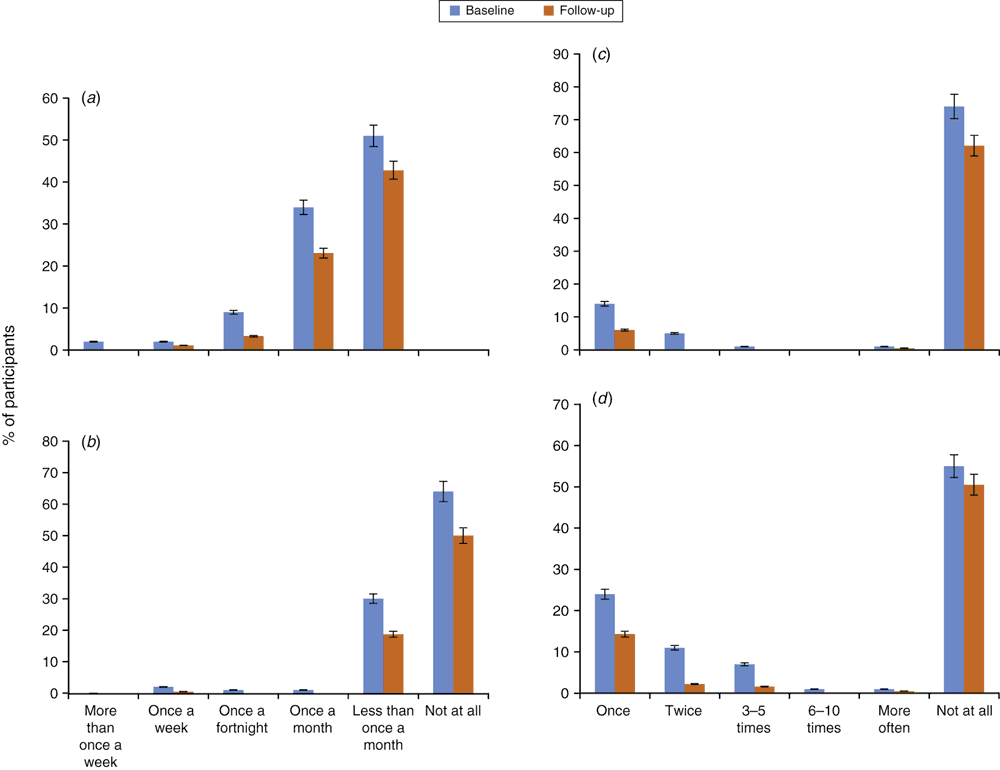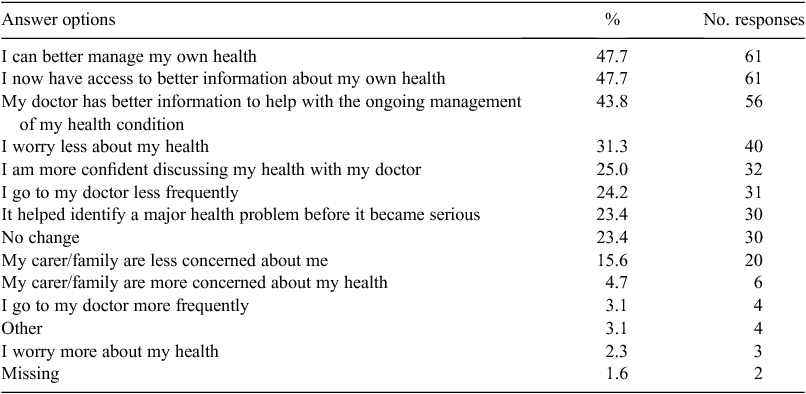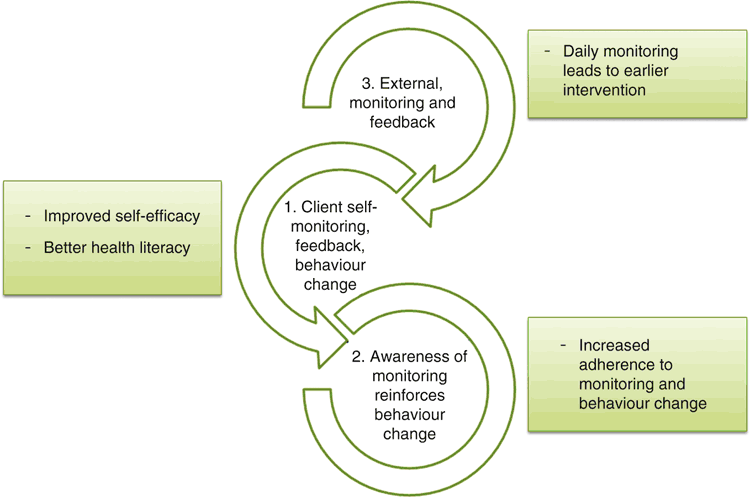Evaluation of a National Broadband Network-enabled Telehealth trial for older people with chronic disease
Susan Nancarrow A C , Annie Banbury A and Jennene Buckley BA Southern Cross University, School of Health and Human Sciences, Military Road East Lismore, Lismore, NSW 2483, Australia. Email: annie.banbury@scu.edu.au
B Feros Care, The Strand at Coolangatta, 72/80 Marine Parade, Coolangata, Qld 4225, Australia. Email: JenneneBuckley@feroscare.com.au
C Corresponding author. Email: susan.nancarrow@scu.edu.au
Australian Health Review 40(6) 641-648 https://doi.org/10.1071/AH15201
Submitted: 28 October 2015 Accepted: 16 December 2015 Published: 31 March 2016
Journal Compilation © AHHA 2016
Abstract
Objective The aim of the present study was to evaluate the effect of a high-speed telemonitoring project for older people with chronic disease in a regional Australian town. Participants’ vital signs were monitored and triaged daily by a telehealth nurse.
Methods A prospective, uncontrolled study design evaluated the effect of home-based telemonitoring on older people with chronic disease. Evaluation included surveys (including the Stanford Chronic Disease Self-Efficacy tool and the Self-Rated Health Questionnaire), self-reported health service use and interviews and focus groups exploring client experiences.
Results Participants reported an improved understanding of their vital signs monitoring (48%) and consequently better self-management of health (48%) and that they were better informed (44%) and more confident (25%) to discuss health with their doctor. Patients also reported making medication changes (17%), positive dietary changes (34%) and increasing their physical activity (33%). Overall, patients’ self-rated general health improved (mean (± s.d.) improvement 0.30 ± 0.80; 95% confidence interval (CI) 0.16–0.45; 118 d.f.; P < 0.001), with more participants reporting that their health is ‘excellent’ or ‘very good’ at the end of the trial. Patients also reported fewer doctor visits (P < 0.001), fewer visits to the local hospital emergency department (P = 0.021) and fewer non-local hospital admissions (P < 0.001) compared with the preceding year. There was no significant reduction in local hospital admissions (P = 0.171).
Conclusions The findings of the present study suggest that telemonitoring with videoconferencing empowers older people to better understand and manage their own health, and is associated with improved health outcomes and reduced service use. Having regular, daily access to a Telehealth nurse reassured participants, and triggered changes to services and behaviour that are likely to have positively affected patient outcomes.
What is known about this topic? Telehealth is increasingly being used in the care of older people with chronic conditions and can reduce health service use. Previous research has indicated that telehealth has the potential to provide patients with greater knowledge and understanding of their condition.
What this paper adds? Our research demonstrates that older people with limited experience of technology can be taught to successfully use telehealth equipment. We observed regular contact with telehealth nurses enables health promoting behaviour messages to be tailored to patients’ needs.
What are the implications for practitioners? Providing older people with tailored health support alongside an understanding of vital signs readings can enhance self-efficacy.
Additional keywords: health behaviour, health service use, patient outcomes, remote monitoring.
Introduction
Telehealth, Telecare and Telerehabilitation interventions are gaining popularity in Australia1–4 and internationally5–7 to help address the needs of aging and dispersed populations, reduce healthcare costs and enhance independence. The introduction of the high-speed Australian National Broadband Network (NBN) provided an opportunity to test the efficacy of Telehealth technology as a way to keep older people independent in their own homes longer7 and to reduce emergency hospital admissions.5
Telehealth has been shown to improve health outcomes8–11 and reduce health service use in specialities such as chronic heart failure, respiratory conditions and diabetes management.8,9,12,13 In chronic heart failure, there is evidence that telemonitoring not only reduces hospital admissions, but may also be effective for disease management in high-risk patients.10 Other studies have shown that telemonitoring is associated with lower rates of mortality for patients.5,8,14 For people with diabetes, Telehealth programs have resulted in patients making fewer clinic visits7 and having considerably fewer hyperglycaemic and hypoglycaemic events.
One of the most important aspects of telemonitoring is the direct involvement of patients in their health care. Telemonitoring can increase patients’ knowledge and awareness of their health condition15,16 and improve self-management behaviours.17 It has the potential to empower and motivate individuals, giving them greater control over their disease management.18–21 However, a review investigating the role of knowledge, self-efficacy and self-care behaviour in Telehealth patients with heart failure concluded that there was insufficient evidence to support or disprove that clinical outcomes and quality of life are affected by these factors.22
This paper reports the findings from the evaluation of an NBN Telehealth trial of Feros Care’s My Health Clinic at Home (MHCAH) system. The aim of the evaluation was to explore the extent to which the NBN could enable health services to be delivered in the home and affect patients’ chronic disease management.
Methods
My Health Clinic at Home
The MHCAH virtual case management model involves home-dwelling older people undertaking remote daily monitoring of their vital signs and well being supported by video conferencing with health professionals, community, family and friends.
In each participant’s home, a Wi-Fi router (using 802.11n) was used to deliver wireless connectivity to the home working on both 2.4 and 5 GHz frequencies. All participants recruited to the study were provided with a computer tablet, with high-definition 720p camera for videoconferencing. Customised patient care peripherals were attached to these devices using short wavelength radio transmissions (Bluetooth over 2400–2480 MHz frequency). All participants were trained by an information technology (IT) technician in the use of the touchscreen tablet, peripherals to undertake vital signs readings and videoconferencing with the Telehealth nurse (THN). Depending on the computer experience and skill level of the client, installation and training took between 2 and 4 h.
The peripheral devices available were blood pressure monitors, pulse oximeters, glucometers, thermometers and weight scales (Fig. 1). Client well being was monitored daily using a routine client ‘interview’. The interview consisted of a prompted online script that directed the client to take their vital signs and respond to a set of ‘well being’ questions. The client interview was then uploaded to a secure database for triage by a THN using ICP Triage Manager software (Tunstall Healthcare; http://www.tunstallhealthcare.com.au/solutions/triagemanager, accessed 3 March 2015) in which a traffic light (green, amber, red) array expedited client triage. If a participant’s readings were outside the parameters set by their general practitioner (GP), they would be contacted by their THN by videoconference. The THN video consultations with participants provided disease-specific health information and general chronic disease management advice. In addition, participants were offered the opportunity to participate in group videoconference programs on health literacy and self-management skills23 and videoconferenced social chat groups. Feros Care sent participants’ GPs monthly trend reports summarising their vital signs readings by either email or fax.
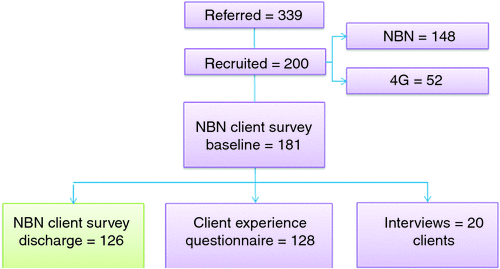
|
Methodology
The evaluation approach was constrained by a very tight time frame for the overall project (initially 12 months, but subsequently extended) and the need to recruit participants who fulfilled specific selection criteria and had access to the NBN. Consequently, it was not possible to include a control group, so a mixed-methods prospective uncontrolled longitudinal study design was used to capture learning on the processes of implementation and the effect of the project on clients. Data sources included surveys with service users and providers, pre- and post-test clinical data and audit data.
The target inclusion criteria for the study were adults aged ≥50 years with at least one chronic disease, access to the NBN, the cognitive ability to perform the readings and the physical ability to use the equipment. One younger participant (<50 years) was recruited towards the end of the project. Most participants were from the Coffs Harbour, New South Wales (NSW) local government area. Participants were recruited to the trial between April 2013 until June 2014 using a range of strategies, including newspaper advertisements, referrals from health professionals, letter box drops and presentations to community groups. Most participants used the NBN platform; however, because of a change in Government strategy towards the end of the project, a small number of participants using 3G and 4G Internet connections were recruited from the Gold Coast, Queensland, and the Far North Coast of NSW. Prior computer experience was not necessary.
An NBN client survey was completed when participants were admitted and discharged from the study. This survey included two validated measures: the General Self-Rated Health (GSRH) question24 and the Self-Efficacy for Managing Chronic Disease (SEMCD) 6-item scale.25 The GSRH is a single question that asks participants to rate their health as excellent, very good, good or poor. It is a widely used tool and a strong predictor of mortality.26 The SEMCD was derived from several self-efficacy scales developed for the Chronic Disease Self-Management study.27 Participants are asked how confident they feel in different aspects of disease self-management using a 10-point scale (from not at all confident to totally confident).
In addition, the NBN client survey incorporated service user questions developed and used in a previous Telehealth survey.28 The survey was completed via an interview with a Feros Care staff member who was also responsible for providing support and training, as well as decommissioning the technology at the end of the trial.
A second survey, the client experience survey, was developed from the findings of in-depth interviews with 20 clients and a literature review. A single survey was mailed to all clients in April 2014; non-respondents were followed up by telephone and, where necessary, the surveys were completed by telephone. Ethics approval was obtained from the Southern Cross University Ethics Committee (ECN-13–056).
Data analysis
All survey data were entered manually into SurveyMonkey by a study administrator and then exported into an Excel (Microsoft, Redmond, WA, USA) spreadsheet, where they were used directly or transferred into IBM SPSS Statistics Version 21.0 (IBM Corporation, Armonk, NY, USA). The data were analysed descriptively, with paired continuous data analysed using Student’s t-test. Changes in categorical variables (specifically health service use) were analysed using the Chi-squared test. Significance was set at P < 0.05. Unless indicated otherwise, data are presented as the mean ± s.e.m.
Results
Two hundred people were recruited to the trial; of those, 181 were sent the NBN client survey and client experience survey. The remaining 19 people were recruited during the last 3 months of the trial period and did not complete these surveys because of the short time period of their involvement and data collection. Most participants were connected to the NBN and recruited from the Coffs Harbour–Sawtell region (n = 148; Fig. 1).
Participants ranged in age from 48 to 98 years (mean (± s.d.) 74.8 ± 8.2 years), most were female (58.5%), lived with their partner or family (63.5%), were non-Indigenous (83.5%) and spoke English as a first language (97%; Table 1). The most commonly reported chronic conditions were high blood pressure (56%) and heart problems (33%; Fig. 1). Clients reported up to six different health conditions, with most (31%) reporting two health conditions (Table 2).
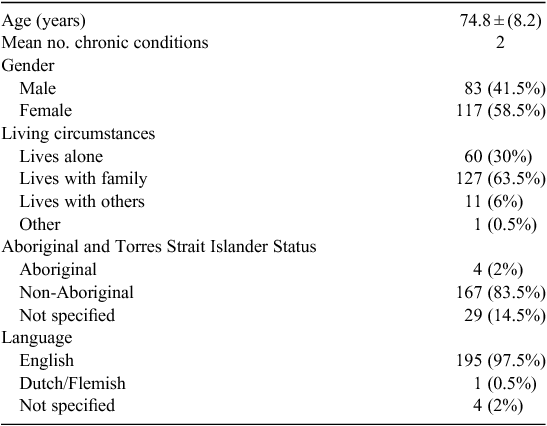
|
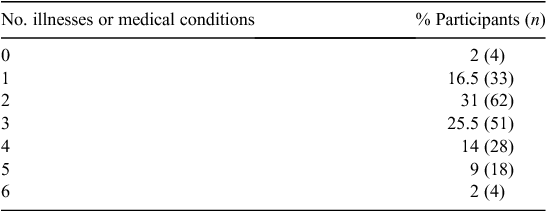
|
Participants used up to five different types of peripheral devices, the most common being the pulse oximeter and blood pressure monitor. Most participants (48%) used three different types of vital signs monitoring equipment (Fig. 2).
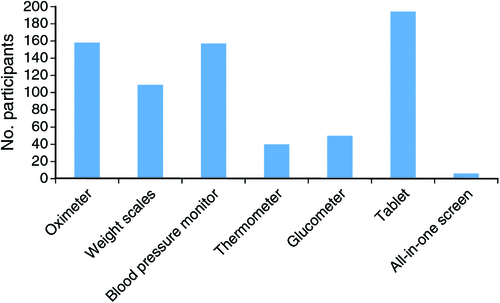
|
NBN client survey
The NBN client survey included questions asking participants about managing their chronic condition, health service use and general health.
There was a significant improvement in the GSRH question across the cohort of 0.30 ± 0.80 (95% confidence interval (CI) 0.16–0.44; 119 d.f.; P < 0.001), with more participants reporting that their health was excellent or very good at the end of the study (Fig. 3). There was an improvement in the SEMCD (Table 3) domains of emotional distress, Pair 3 (How confident are you that you can keep the emotional distress caused by your disease from interfering with the things you want to do?; (0.66 ± 0.26; 95% CI 1.18–0.13; 118 d.f.; P = 0.015) and Pair 6 (How confident are you that you can do things other than just taking medication to reduce how much your illness affects your everyday life?; 0.94 ± 0.29; 95% CI 1.5–0.37; 107 d.f.; P = 0.001), as well as a 0.47 ± 0.23 mean improvement (95% CI 0.93–0.11; 103 d.f.; P = 0.045) in the overall self-efficacy summary score.
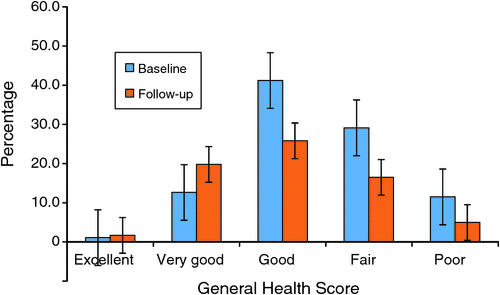
|

|
Self-reported health service use showed a decline in the number of GP visits (Fig. 4a, χ2 52.851; n = 122; 12 d.f.; P < 0.001), emergency department admission (Fig. 4b; χ2 14.950; n = 122; 6 d.f.; P = 0.021) and admissions to other (non-local) hospitals (Fig. 4c; χ2 61.44; n = 118; 12 d.f.; P < 0.001). However, there was no significant difference in admission rates to the local hospital (Fig. 4d; χ2 21.190; n = 122; 16 d.f.; P = 0.171).
Client experience survey
Most people said that the reason they participated in the MHCAH system was to identify health problems before they become serious (65%), better manage their own health (58%), receive better information about their own health (53%) and for reassurance that someone is keeping an eye on them (51%).
Based on results of the client experience survey (Table 4) these expectations were largely met. Participants reported that as a result of participation in the study they could better manage their own health (48%), had access to better information about their own health (48%), had less frequent doctor visits (24%) and that their doctor had better information to help with the ongoing management of their health conditions (44%). In addition, nearly one-third of clients (31%) said that they worried less about their health and 25% were more confident discussing their health conditions with their doctor as a result of their vital signs monitoring.
Other benefits that participants attributed to their involvement in the MHCAH system included going out more (15%), medication changes (16%), positive dietary changes and understanding (34%), eating more fruit and vegetables (28%), drinking more water (39%), increased physical activity (33%) and a better understanding of their vital signs monitoring (47%; Table 5).
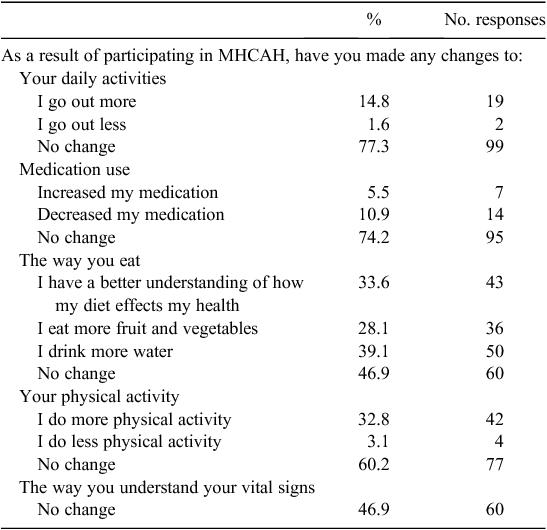
|
Approximately equal numbers of experienced (35%) and novice (35%) computer users participated in the trial (Table 6). The remaining participants (27%) reported a moderate level of confidence with computer use. Most participants had never used videoconferencing facilities before the trial (74%).

|
Discussion
The study participants reported a significant increase in their general health and their self-efficacy to manage their chronic diseases during their trial participation. In line with other studies, the data suggest that the use of telemonitoring is associated with reduced frequency of visits to hospitals,7,16,29 the emergency department30 and general practice.
Despite their older age and varying levels of technological experience and literacy, participants found the technology easy to use and were able to adhere to daily telemonitoring.8,31,32 Clients derived a sense of security and better information to manage their own health8,33 and found the technology facilitated communication with their health practitioners. Consequently, clients were more empowered and had a better understanding of their health conditions.34,35 The reasons for these effects were multifaceted, but we suggest two key mechanisms (Fig. 5). First, the self-monitoring of vital signs by clients led to better knowledge and understanding of their health conditions, resulting in positive behavioural changes that enhanced their health outcomes. Clients were responsible for taking their vital signs and were in control of using the equipment. They were exposed to vital signs readings on a daily basis, as opposed to usual care, where often only the health practitioner knows the results of the readings taken when patients visit a clinic setting. Other studies have demonstrated the self-regulatory effect of self-monitoring interventions.36–38 In addition, participants had easy access to a THN to explain the readings as well as to provide timely advice on health promoting and self-management behaviours. The THNs were able to provide advice, taking into consideration the idiosyncrasies and knowledge of the patient they acquired over time.39,40 We suggest that this resulted in greater tailoring of health information from the THN, as well as improving participants’ knowledge and understanding of the relationship between their health behaviour and their vital signs readings. The increased knowledge and understanding of their condition led to participants increasing positive behaviours, such as eating more fruit and vegetables, drinking more water and increasing physical activity. The effects of the positive behaviours could be easily tracked by participants because their vital signs readings were performed daily and they could clearly see the benefits of changing their behaviour. The use of Telehealth to enable participants to clearly link improved health behaviours and improved health outcomes may provide important motivating influences on self-care behaviour.
The second key mechanism in improving clients’ health behaviour was the external monitoring (surveillance) of clients by the THN, which resulted in early intervention when a potential health problem was identified. Although it could not be quantified in this project, this was likely to have reduced more serious consequences arising from a delayed intervention. There was also a likely interaction between the self-monitoring and external surveillance, resulting in reinforcement of client self-monitoring behaviour and a perception of social support for the clients. Further research is needed to test these assumptions.
A review of older patients using Telehealth concluded that studies that included personal contact between the patients and a healthcare provider showed better results compared with studies without personal contact.41 However, THNs may perceive that patients are integrating information into their daily care, whereas patients report they are not.42 The present study suggests that patients do integrate the information into their daily care, but further research is required to understand the optimum communication mechanisms to enhance health behaviours through telemonitoring.
The MHCAH trial was a highly ambitious trial and although the study demonstrates feasibility, the authors acknowledge there are limitations to this longitudinal study. First, without a control group, our ability to draw causal links was limited. Second, the short time frame of the trial meant that longer-term follow-up was not captured. Third, because of the tight recruitment time frames set by the funders and the limited geographic coverage of the NBN, participants were self-referred rather than recruited through traditional sources, such as through health professionals and hospitals. Participants were motivated by several factors, including wanting to better manage their health. Approximately one-third of participants were experienced computer users. There was a likely degree of self-selection bias among participants, who were conceivably more technically literate and engaged that the wider population. Therefore, these results relate to willing participants who are motivated to use new technology to enhance their health and did not have any significant reservation about monitoring or surveillance through a telecare system.43 However, it is important to understand which patients would most likely benefit from telemonitoring44 because attempting to use telemonitoring with older participants who do not want to use telemonitoring could result in ineffective health care and inefficient use of scarce resources.45
Telehealth is believed to provide the opportunity to empower and motivate patients to gain greater control over disease management.19,40,45 However, little is known about the processes by which telehealth may do this.22 The present study provides insights into the mechanisms by which patients can be more engaged with their health care and self-management, which can lead to a better understanding of their condition, improved health behaviours and improved self-management, as perceived by the patient.
Telemonitoring is a rapidly growing area for patients with chronic conditions. It has the potential to reduce healthcare use, improve patients’ understanding of their vital signs and the effect of their health behaviours. Telemonitoring in conjunction with tailored health messages can increase health promoting behaviours.
Competing interests
Jennene Buckley is the CEO of Feros Care who was awarded funding by the Australian Government for this study.
Acknowledgements
This project was funded by the Australian Government Department of Health and Ageing (DoHA) under the National Digital Economy Strategy as a trial of the NBN.
References
[1] Feros Care. Supporting people to live safely and independently at home: An Australian pilot program. Coolangatta: Feros Care; 2010.[2] Sharma S, Ward EC, Burns C, Theodoros D, Russell T. Assessing swallowing disorders online: a pilot telerehabilitation study. Telemed J E Health 2011; 17 688–95.
| Assessing swallowing disorders online: a pilot telerehabilitation study.Crossref | GoogleScholarGoogle Scholar | 21882996PubMed |
[3] Smith AC, Caffery LJ, Saunders R, Bradford NK, Gray LC. Generating new telehealth services using a whole of community approach: experience in regional Queensland. J Telemed Telecare 2014; 20 365–9.
| Generating new telehealth services using a whole of community approach: experience in regional Queensland.Crossref | GoogleScholarGoogle Scholar | 25399996PubMed |
[4] Crotty M, Killington M, van den Berg M, Morris C, Taylor A, Carati C. Telerehabilitation for older people using off-the-shelf applications: acceptability and feasibility. J Telemed Telecare 2014; 20 370–6.
| Telerehabilitation for older people using off-the-shelf applications: acceptability and feasibility.Crossref | GoogleScholarGoogle Scholar | 25399997PubMed |
[5] Steventon A, Bardsley M, Billings J, Dixon J, Doll H, Hirani S, Cartwright M, Rixon L, Knapp M, Henderson C, Rogers A, Fitzpatrick R, Newman S. Effect of telehealth on use of secondary care and mortality: findings from the Whole System Demonstrator cluster randomised trial. BMJ 2012; 344 e3874
| Effect of telehealth on use of secondary care and mortality: findings from the Whole System Demonstrator cluster randomised trial.Crossref | GoogleScholarGoogle Scholar | 22723612PubMed |
[6] Darkins A, Ryan P, Kobb R, Foster L, Edmonson E, Wakefield B, Lancaster AE. Care coordination/home telehealth: the systematic implementation of health informatics, home telehealth, and disease management to support the care of veteran patients with chronic conditions. Telemed J E Health 2008; 14 1118–26.
| Care coordination/home telehealth: the systematic implementation of health informatics, home telehealth, and disease management to support the care of veteran patients with chronic conditions.Crossref | GoogleScholarGoogle Scholar | 19119835PubMed |
[7] Barnett TE, Chumbler NR, Vogel WB, Beyth RJ, Qin H, Kobb R. The effectiveness of a care coordination home telehealth program for veterans with diabetes mellitus: a 2-year follow-up. Am J Manag Care 2006; 12 467–74.
| 16886889PubMed |
[8] Inglis SC, Clark RA, McAlister FA, Stewart S, Cleland JG. Which components of heart failure programmes are effective? A systematic review and meta‐analysis of the outcomes of structured telephone support or telemonitoring as the primary component of chronic heart failure management in 8323 patients: abridged Cochrane review. Eur J Heart Fail 2011; 13 1028–40.
| Which components of heart failure programmes are effective? A systematic review and meta‐analysis of the outcomes of structured telephone support or telemonitoring as the primary component of chronic heart failure management in 8323 patients: abridged Cochrane review.Crossref | GoogleScholarGoogle Scholar | 21733889PubMed |
[9] Purcell R, McInnes S, Halcomb EJ. Telemonitoring can assist in managing cardiovascular disease in primary care: a systematic review of systematic reviews. BMC Fam Pract 2014; 15 43
| Telemonitoring can assist in managing cardiovascular disease in primary care: a systematic review of systematic reviews.Crossref | GoogleScholarGoogle Scholar | 24606887PubMed |
[10] Chaudhry SI, Phillips CO, Stewart SS, Riegel B, Mattera JA, Jerant AF, Krumholz HM. Telemonitoring for patients with chronic heart failure: a systematic review. J Card Fail 2007; 13 56–62.
| Telemonitoring for patients with chronic heart failure: a systematic review.Crossref | GoogleScholarGoogle Scholar | 17339004PubMed |
[11] Kairy D, Lehoux P, Vincent C, Visintin M. A systematic review of clinical outcomes, clinical process, healthcare utilization and costs associated with telerehabilitation. Disabil Rehabil 2009; 31 427–47.
| A systematic review of clinical outcomes, clinical process, healthcare utilization and costs associated with telerehabilitation.Crossref | GoogleScholarGoogle Scholar | 18720118PubMed |
[12] Barlow J, Singh D, Bayer S, Curry R. A systematic review of the benefits of home telecare for frail elderly people and those with long-term conditions. J Telemed Telecare 2007; 13 172–9.
| A systematic review of the benefits of home telecare for frail elderly people and those with long-term conditions.Crossref | GoogleScholarGoogle Scholar | 17565772PubMed |
[13] Polisena J, Tran K, Cimon K, Hutton B, McGill S, Palmer K. Home telehealth for diabetes management: a systematic review and meta‐analysis. Diabetes Obes Metab 2009; 11 913–30.
| Home telehealth for diabetes management: a systematic review and meta‐analysis.Crossref | GoogleScholarGoogle Scholar | 1:STN:280:DC%2BD1MnisVWjtA%3D%3D&md5=1f618b407eff32dd026ece942005cd6aCAS | 19531058PubMed |
[14] Chumbler NR, Chuang H-C, Wu SS, Wang X, Kobb R, Haggstrom D, Jia H. Mortality risk for diabetes patients in a care coordination, home-telehealth programme. J Telemed Telecare 2009; 15 98–101.
| Mortality risk for diabetes patients in a care coordination, home-telehealth programme.Crossref | GoogleScholarGoogle Scholar | 19246611PubMed |
[15] Dinesen B, Haesum LK, Soerensen N, Nielsen C, Grann O, Hejlesen O, Toft E, Ehlers L. Using preventive home monitoring to reduce hospital admission rates and reduce costs: a case study of telehealth among chronic obstructive pulmonary disease patients. J Telemed Telecare 2012; 18 221–5.
| Using preventive home monitoring to reduce hospital admission rates and reduce costs: a case study of telehealth among chronic obstructive pulmonary disease patients.Crossref | GoogleScholarGoogle Scholar | 22653618PubMed |
[16] Paré G, Jaana M, Sicotte C. Systematic review of home telemonitoring for chronic diseases: the evidence base. J Am Med Inform Assoc 2007; 14 269–77.
| Systematic review of home telemonitoring for chronic diseases: the evidence base.Crossref | GoogleScholarGoogle Scholar | 17329725PubMed |
[17] LaFramboise LM, Todero CM, Zimmerman L, Agrawal S. Comparison of Health Buddy® with traditional approaches to heart failure management. Fam Community Health 2003; 26 275–88.
| Comparison of Health Buddy® with traditional approaches to heart failure management.Crossref | GoogleScholarGoogle Scholar | 14528134PubMed |
[18] Finch TL, Mort M, Mair FS, May CR. Future patients? Telehealthcare, roles and responsibilities. Health Soc Care Community 2008; 16 86–95.
| Future patients? Telehealthcare, roles and responsibilities.Crossref | GoogleScholarGoogle Scholar | 18181818PubMed |
[19] Atkin P, Barrett D. Benefits of telemonitoring in the care of patients with heart failure. Nurs Stand 2012; 27 44–8.
| Benefits of telemonitoring in the care of patients with heart failure.Crossref | GoogleScholarGoogle Scholar | 1:STN:280:DC%2BC3s%2FosVagug%3D%3D&md5=9664aea787ae45c9bcef5c4db83ff1b4CAS | 23101298PubMed |
[20] Seto E, Leonard KJ, Cafazzo JA, Barnsley J, Masino C, Ross HJ. Perceptions and experiences of heart failure patients and clinicians on the use of mobile phone-based telemonitoring. J Med Internet Res 2012; 14 e25
| Perceptions and experiences of heart failure patients and clinicians on the use of mobile phone-based telemonitoring.Crossref | GoogleScholarGoogle Scholar | 22328237PubMed |
[21] Bujnowska-Fedak MM, Puchała E, Steciwko A. The impact of telehome care on health status and quality of life among patients with diabetes in a primary care setting in Poland. Telemed J E Health 2011; 17 153–63.
| The impact of telehome care on health status and quality of life among patients with diabetes in a primary care setting in Poland.Crossref | GoogleScholarGoogle Scholar | 21375410PubMed |
[22] Ciere Y, Cartwright M, Newman SP. A systematic review of the mediating role of knowledge, self-efficacy and self-care behaviour in telehealth patients with heart failure. J Telemed Telecare 2012; 18 384–91.
| A systematic review of the mediating role of knowledge, self-efficacy and self-care behaviour in telehealth patients with heart failure.Crossref | GoogleScholarGoogle Scholar | 23019605PubMed |
[23] Banbury A, Parkinson L, Nancarrow S, Dart J, Gray L, Buckley J. Multi-site videoconferencing for home-based education of older people with chronic conditions: the Telehealth Literacy Project. J Telemed Telecare 2014; 20 353–9.
| Multi-site videoconferencing for home-based education of older people with chronic conditions: the Telehealth Literacy Project.Crossref | GoogleScholarGoogle Scholar | 25399994PubMed |
[24] Mossey JM, Shapiro E. Self-rated health: a predictor of mortality among the elderly. Am J Public Health 1982; 72 800–8.
| Self-rated health: a predictor of mortality among the elderly.Crossref | GoogleScholarGoogle Scholar | 1:STN:280:DyaL383ivVansw%3D%3D&md5=259e62b903ab7e87032b5597a3a102cbCAS | 7091475PubMed |
[25] Lorig K, Sobel D, Ritter P, Laurent D, Hobbs M. Self-efficacy for managing chronic disease 6-item scale. Palo Alto: Stanford Patient Education Research Centre; 2001. Available at: http://patienteducation.stanford.edu/research/secd6.html [verified 3 March 2015].
[26] DeSalvo KB, Bloser N, Reynolds K, He J, Muntner P. Mortality prediction with a single general self‐rated health question. J Gen Intern Med 2006; 21 267–75.
| Mortality prediction with a single general self‐rated health question.Crossref | GoogleScholarGoogle Scholar | 16336622PubMed |
[27] Lorig K. Outcome measures for health education and other health care interventions. Thousand Oaks, CA: Sage; 1996.
[28] Cartwright C, Wade R, Shaw K. The impact of telehealth and telecare on clients of the transition care program (TCP). Lismore: Southern Cross University, Australian Department of Health and Ageing; 2011.
[29] Chen Y-H, Lin Y-H, Hung C-S, Huang C-C, Yeih D-F, Chuang P-Y, Ho Y-L, Chen M-F. Clinical outcome and cost-effectiveness of a synchronous telehealth service for seniors and nonseniors with cardiovascular diseases: quasi-experimental study. J Med Internet Res 2013; 15 e87
| 23615318PubMed |
[30] Moore J. Primary care heart failure services. Br J Cardiol 2008; 15 6
[31] Botsis T, Demiris G, Pedersen S, Hartvigsen G. Home telecare technologies for the elderly. J Telemed Telecare 2008; 14 333–7.
| Home telecare technologies for the elderly.Crossref | GoogleScholarGoogle Scholar | 18852311PubMed |
[32] Terschüren C, Fendrich K, van den Berg N, Hoffmann W. Implementing telemonitoring in the daily routine of a GP practice in a rural setting in northern Germany. J Telemed Telecare 2007; 13 197–201.
| Implementing telemonitoring in the daily routine of a GP practice in a rural setting in northern Germany.Crossref | GoogleScholarGoogle Scholar | 17565776PubMed |
[33] Botsis T, Hartvigsen G. Current status and future perspectives in telecare for elderly people suffering from chronic diseases. J Telemed Telecare 2008; 14 195–203.
| Current status and future perspectives in telecare for elderly people suffering from chronic diseases.Crossref | GoogleScholarGoogle Scholar | 18534954PubMed |
[34] MacNeill V, Sanders C, Fitzpatrick R, Hendy J, Barlow J, Knapp M, Rogers A, Bardsley M, Newman SP. Experiences of front-line health professionals in the delivery of telehealth: a qualitative study. Br J Gen Pract 2014; 64 e401–7.
| Experiences of front-line health professionals in the delivery of telehealth: a qualitative study.Crossref | GoogleScholarGoogle Scholar | 24982492PubMed |
[35] Barrett D. The role of telemonitoring in caring for older people with long-term conditions. Nurs Older People 2012; 24 21–5.
| The role of telemonitoring in caring for older people with long-term conditions.Crossref | GoogleScholarGoogle Scholar | 23008916PubMed |
[36] Schwarzer R. Modeling health behavior change: how to predict and modify the adoption and maintenance of health behaviors. Appl Psychol 2008; 57 1–29.
[37] Schwarzer R, Antoniuk A, Gholami M. A brief intervention changing oral self‐care, self‐efficacy, and self‐monitoring. Br J Health Psychol 2015; 20 56–67.
| A brief intervention changing oral self‐care, self‐efficacy, and self‐monitoring.Crossref | GoogleScholarGoogle Scholar | 24471473PubMed |
[38] Greenwood DA, Young HM, Quinn CC. Telehealth remote monitoring systematic review: structured self-monitoring of blood glucose and impact on A1c. J Diabetes Sci Technol 2014; 8 378–89.
| Telehealth remote monitoring systematic review: structured self-monitoring of blood glucose and impact on A1c.Crossref | GoogleScholarGoogle Scholar | 24876591PubMed |
[39] Duke C. The frail elderly community-based case management project. Geriatr Nurs 2005; 26 122–7.
| The frail elderly community-based case management project.Crossref | GoogleScholarGoogle Scholar | 15824728PubMed |
[40] Segar J, Rogers A, Salisbury C, Thomas C. Roles and identities in transition: boundaries of work and inter‐professional relationships at the interface between telehealth and primary care. Health Soc Care Community 2013; 21 606–13.
| 23656381PubMed |
[41] van den Berg N, Schumann M, Kraft K, Hoffmann W. Telemedicine and telecare for older patients: a systematic review. Maturitas 2012; 73 94–114.
| Telemedicine and telecare for older patients: a systematic review.Crossref | GoogleScholarGoogle Scholar | 22809497PubMed |
[42] Shea K, Chamoff B. Telehomecare communication and self‐care in chronic conditions: moving toward a shared understanding. Worldviews Evid Based Nurs 2012; 9 109–16.
| Telehomecare communication and self‐care in chronic conditions: moving toward a shared understanding.Crossref | GoogleScholarGoogle Scholar | 22409374PubMed |
[43] Essén A. The two facets of electronic care surveillance: an exploration of the views of older people who live with monitoring devices. Soc Sci Med 2008; 67 128–36.
| The two facets of electronic care surveillance: an exploration of the views of older people who live with monitoring devices.Crossref | GoogleScholarGoogle Scholar | 18396367PubMed |
[44] Giamouzis G, Mastrogiannis D, Koutrakis K, Karayannis G, Parisis C, Rountas C, Adreanides E, Dafoulas GE, Stafylas PC, Skoularigis J, Giacomelli S, Olivari Z, Triposkiadis F. Telemonitoring in chronic heart failure: a systematic review. Cardiol Res Pract 2012; 2012 410820
| Telemonitoring in chronic heart failure: a systematic review.Crossref | GoogleScholarGoogle Scholar | 22720184PubMed |
[45] Milligan C, Roberts C, Mort M. Telecare and older people: who cares where? Soc Sci Med 2011; 72 347–54.
| Telecare and older people: who cares where?Crossref | GoogleScholarGoogle Scholar | 20880624PubMed |


